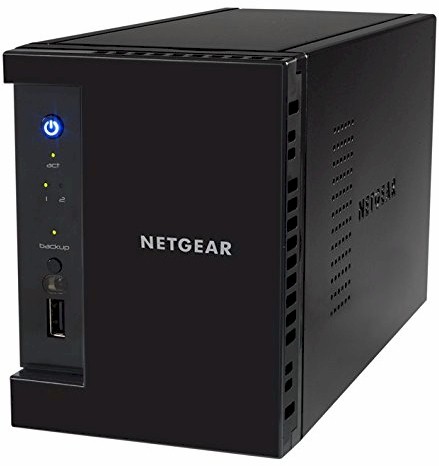
| At a glance | |
|---|---|
| Product | NETGEAR ReadyNAS 202 (RN202-100NES) [Website] |
| Summary | Two bay dual-core Annapura Labs based NAS with OS based on BTRFS with built-in antivirus |
| Pros | • Built-in antivirus • Unlimited volume snapshots • Cloud based replication, access, drop folder |
| Cons | • No HDMI port • Relatively slower attached backup and iSCSI performance than competitors |
Typical Price: $160 Buy From Amazon
Introduction
NETGEAR announced its ReadyNAS 200 family at CES 2015. The RN202 and RN204 models are basically more powerful versions of the ReadyNAS 100 family we reviewed in the form of the RN102 about two years ago. In this review, I’ll be looking at the two-bay RN202.
From the outside, the RN202 looks identical to the RN102, but features an updated processor as well as 2 GB of RAM. In addition, all three USB ports on the RN202 are now USB 3.0, and the RN202 adds a second Gigabit Ethernet port capable of link aggregation. The RN202 also supports 6 TB disks. The table below summarizes the key differences between the RN102 and the RN202.
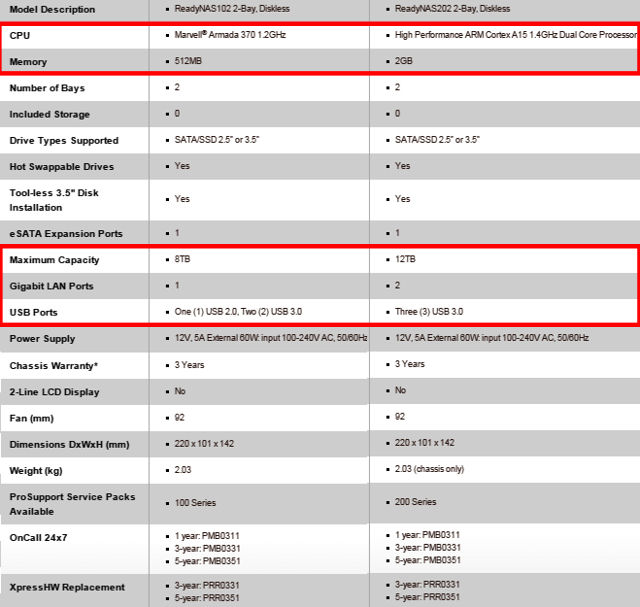
Table 1: Comparison between the RN102 and the RN202
The image below shows the front (left) and rear (right) panel callouts. On the front panel, there’s a Power LED (top), disk activity LED, single USB 3.0 port, backup button, LEDs for USB and backup status as well as individual status LEDs for Disk 1 and Disk 2.
On the rear panel, you’ll find two USB 3.0 ports, two Gigabit Ethernet LAN ports with LED status indicators, eSATA port and a Kensington lock slot. The fan and power connector round out the rear panel.
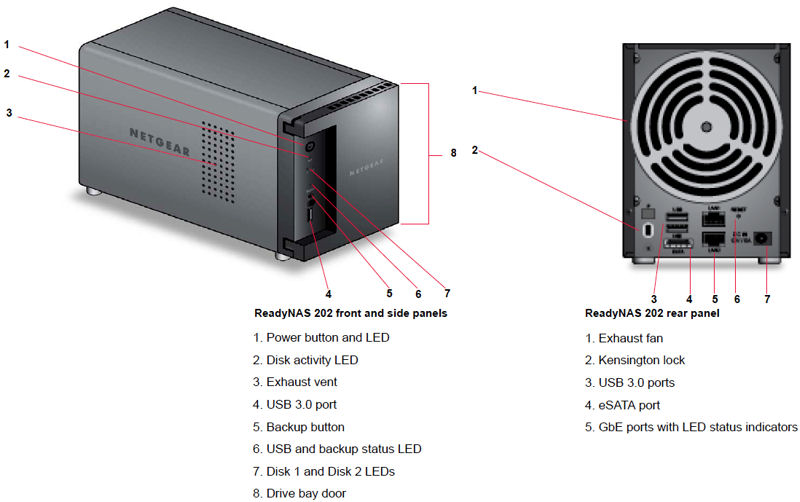
NETGEAR RN202 Callouts – Front panel (left) and Rear panel (right)
Inside
The image below shows the main board for the RN202. The heatsink has been removed to show the processor.
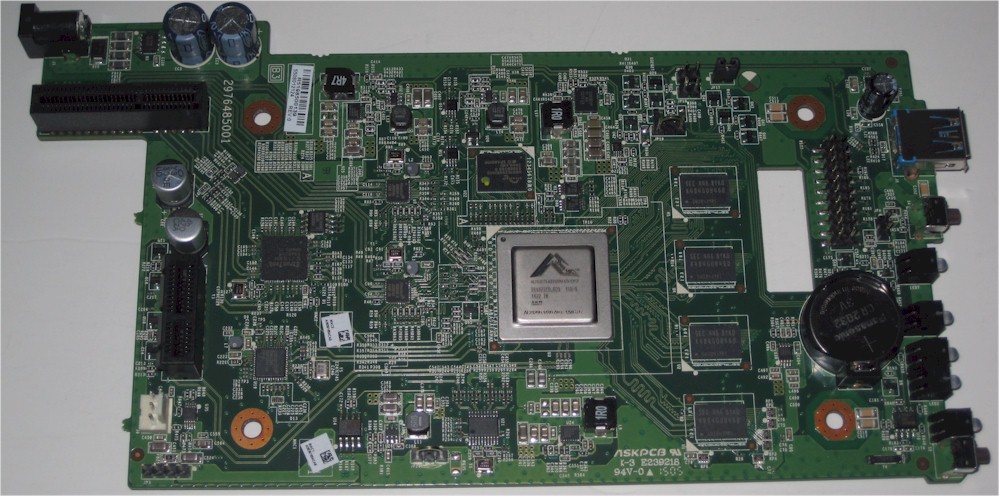
NETGEAR RN202 main PCB
The RN102’s key components are summarized in Table 1 along with a comparison to the ASUSTOR AS5002T and the QNAP TS-251 Turbo NAS. All of the three NASes have very similar price points and performance and will be used for comparison throughout this review.
As an interesting side note, this is the first NAS we’ve reviewed that features a CPU from Annapurna Labs, an Israeli chip maker. The ReadyNAS 200’s are likely to be the last NASes we’ll see with these processors, because Amazon purchased the company at the beginning of this year.
| Model | NETGEAR RN202 | ASUSTOR AS5002T | QNAP TS-251 |
|---|---|---|---|
| CPU | Annapurna Labs 1.4 GHz ARM Cortex A15 Dual Core SoC (AL21200-1400-A0-E-1AN-8-C) | Intel Celeron J1800@ 2.4GHz (dual core) | Intel Celeron J1800 dual-core processor @ 2.4 GHz |
| RAM | 2 GB DDR3 on board Samsung K4B4G0846D (x4) | 1 GB DDR3 SoDIMM, upgradeable to 8 GB | 1 GB DDR3 SoDIMM (expandable to 8 GB) |
| Flash | 64 MB | ADATA IUM01-001GFHL (128 MB USB DOM) | 512 MB DOM |
| Ethernet | Atheros AR8035 (x2) | Broadcom BCM57781 (x2) | Intel WGI210TA (x2) |
| SATA | Asmedia ASM1060 6 Gbps SATA controller | ASM1061 ASM1466 | Asmedia ASM1061 |
| USB 3.0 | Etron Tech EJ188H 2 port USB 3.0 Host Controller | ASM1074 | Asmedia 1074 USB 3.0 quad port hub |
Table 1: Key component summary and comparison
Features
The RN202 is running an updated version of ReadyNAS OS6.2. I reviewed ReadyNAS 6.0 when it was originally released in mid-2013 and again last December when Version 6.2, a major upgrade, became available. The Version 6.2 review drills down into the latest features and is worth checking out. To give you a feel for ReadyNAS, here’s a screenshot from my RN104.
I updated the firmware with the latest version available for this model, but it appears to be slightly behind the version tested on the RN202. NETGEAR explained the key difference between 6.2.4 and 6.3.4 is the newer kernel series needed to support the RN202 hardware. NETGEAR said it eventually plans to migrate to a common firmware version for all ReadyNASes.
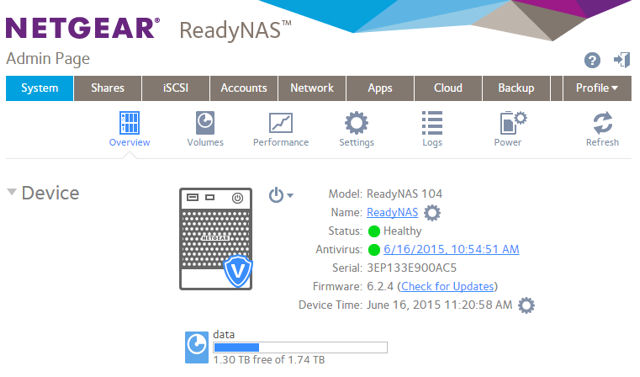
ReadyNAS Landing page on my RN104
Performance
We tested using two WD Green 1 TB (WD10EZRX) drives NETGEAR supplied with the product. Power consumption was measured at 21 W in active mode and 13 W in power save mode. Fan and drive noise was rated as low. Performance tests were run using our Revision 5 NAS test process on two-drive unencrypted RAID 0 and RAID1 volumes with a 1 Gbps LAN connection. The firmware installed was ReadyNAS OS6.3.4.
The comparative benchmark summary below shows the NETGEAR RN202 (left), the ASUSTOR AS5002T (center) and the QNAP TS-251 (right). All three products had very similar results for File Copy Write and Read results for both RAID 0 and RAID 1. Likewise, NASPT results for RAID 0 and 1 were also very similar, with different products scoring better on one test and poorer on another test, but all within a fairly limited range.
Only the RN202 and the AS5002T have eSATA ports, so those backup tests couldn’t be run on the QNAP. The AS5002T easily bested the RN204 on both FAT and EXT3 tests, but tied for NTFS. The RN202 has only USB 3.0 ports, so USB 2.0 tests weren’t run. For USB 3.0 backup tests, both the ASUSTOR and the QNAP outperformed the RN202 for FAT and EXT3 formats, but it came in second behind the QNAP for NTFS backups. For iSCSI, the RN202 turned in poorer performance than either the AS5002T or the TS-251 for both the iSCSI write and iSCSI read tests. You’ll see the impact of these results in the NAS Ranker Performance summary below.
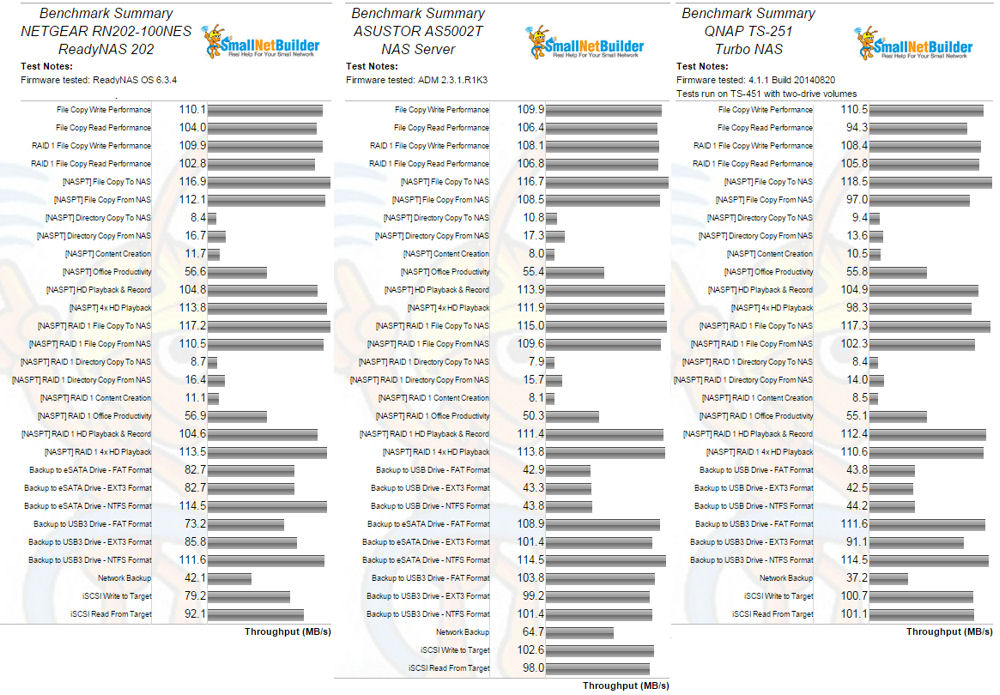
Comparative Benchmark Summary
NAS Ranker
To see how the NETGEAR RN202 stacked up against other RAID 1 NASes, I filtered for RAID1 class and Test Method Revision 5. The RN202, with a Total NAS score of 3.5, tied for #3 ranking with the QNAP TS-251. The ASUSTOR AS5002T, with a Total NAS score of 2.2 was ranked #2. The top performer was the ASUSTOR AS5102T, a sibling of the AS5002T, but with a beefier J1900 processor. The image below shows the RAID1 NAS ranker sorted by rank (left) and by price (right).
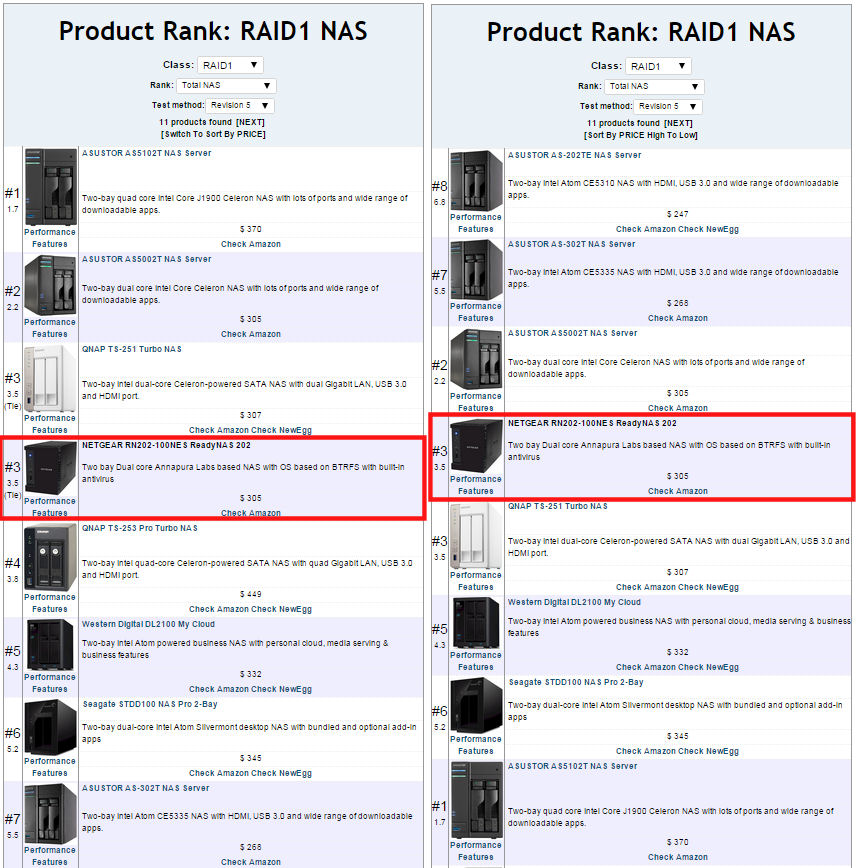
RAID 1 NAS rankings (left) and sorted by price (right)
For a more detailed look at comparative performance, I created the composite Ranker Performance summary below showing the NETGEAR RN202 (left), the ASUSTOR AS5002T (center) and the QNAP TS-251 (right). The RN202 had its best category performance for Mixed Read Write where it was ranked #1, ahead of the #2 ranked TS-251 and the #4 ranked AS5002T. It had similar high-ranking category performance for Read Benchmarks where it ranked #2, just behind the #1 ASUSTOR. But category rankings for Write benchmarks (#5), Backup (#5) and iSCSI (#6) pulled the overall ranking for the RN202 down to #3. It’s interesting to note that the QNAP TS-251, tied at #3 had different rankings for every category, but still managed a tie.
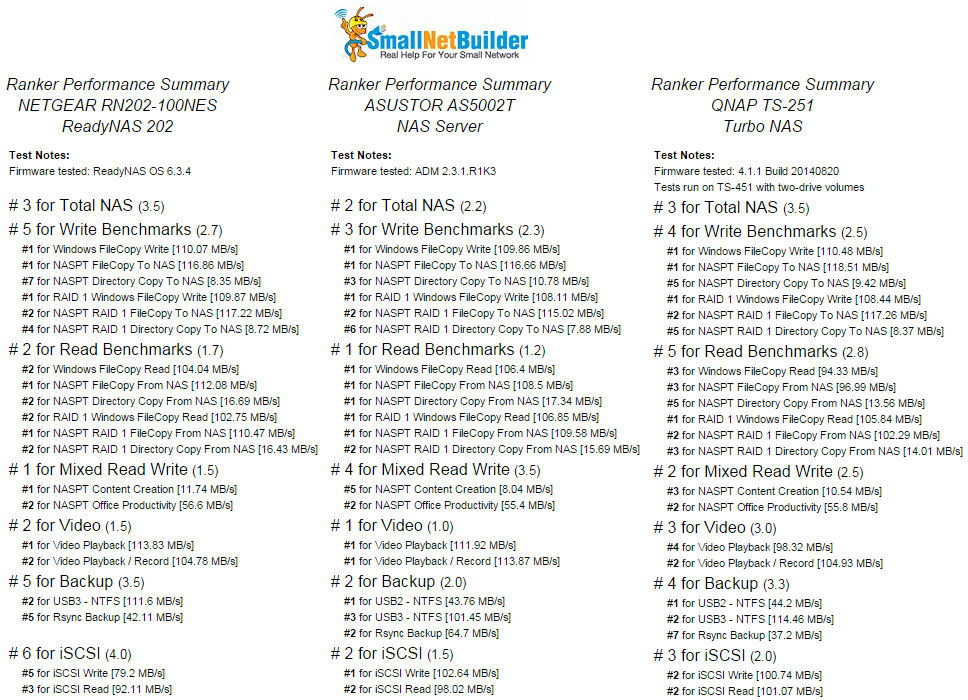
NAS Ranker Performance Comparison for the NETGEAR RN202 (left), the ASUSTOR AS5002T (center) and the QNAP TS-251 (right)
Closing Thoughts
It’s rare to review a NAS and have two competing products with such similar performance and pricing. Often a large difference in performance or price makes the purchasing decision very easy. But as I write this, prices of the three compared products were separated by only $2. It’s worth noting that prices on Amazon can, and often do, change daily. For example, when I started this review, the QNAP TS-251 was priced at $287. By the time I finished, it jumped from being the cheapest in this comparison to being the most expensive at $307.
Since neither price nor performance is going to drive a purchasing decision among these three products, the decision is going to come down to features. If you’re interested in connecting your NAS directly to your HDTV for video playback, only the QNAP and the ASUSTOR have HDMI and audio out ports. Similarly, only the RN202 and the AS5002T have eSATA ports for backup. But for backup, I think that the NETGEAR RN202, with its snapshot technology enabled by the BTFRS file system provides the widest range of backup options.
No matter which of these you choose, you’ll be getting a good performing, feature-packed two-bay NAS that’s likely to meet your needs.![]()
